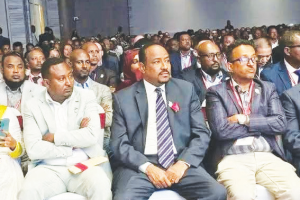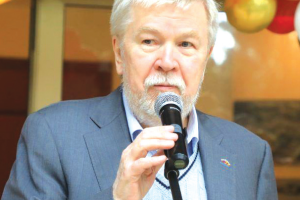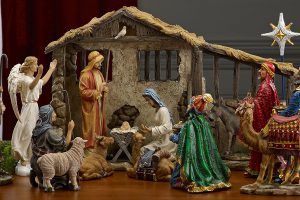
Last Saturday, I made up my mind to go to the National Museum of Ethiopia found in the heart of Amist Kilo area in Addis Ababa with a view to exploring across-the-board impression of the country’s instinctive, political as well as art histories.
Though amazing things happen every so often in the museum, I was not able to pay a visit to it owing to unforeseen reasons. I feel like I am a big loser and ashamed of myself in this regard.
When I arrived at the front gate of the museum, I came across police officers at the checkpoint. Having my bag checked, I headed straight to the premises of the eye-catching museum building. The left, right and center of the museum were bedecked with attention-grabbing flowers.
It has the capacity of attracting visitors’ hearts at the stroke of a pen. The whole lot was too wonderful for words and beggaring description without exaggeration.
More often than not, I overheard the National Museum of Ethiopia put on view a wide-ranging synopsis of Ethiopia’s natural, political and art histories and other related aspects.
When I looked around the buildings of the museum, I bumped into student visitors coming from a wide spectrum of schools positioned in every nook and cranny of Addis Ababa.
They were adorning themselves head to foot with attention-grabbing school uniform. Some of them were sitting on the ground crossed legs while others were standing arms akimbo and with their arms crossed. Most students were splitting their sides with laughter and taking about the archaeological and paleoanthropological sections of the museum. They were very happy indeed.
In the same way, apart from having their pictures taken, the students were facilitating small group discussion. Some of them were busy talking about Emperor Menelik II gun, the obelisk of Axum, the statues of Haileselassie I and other types of tourist attractions planted around the main gate of the National Museum of Ethiopia.
After I went far deep in thought for a split second pertaining to the students’ visit, I realized the significance of domestic tourism seeing that it plays a great role in boosting the country’s economy without a shadow of a doubt.
Be that as it may, when I looked around the premises of the museum, I chanced upon the status of Emperor Haileselassie I surrounded by quite a lot of foreign visitors.
They knew the story of the emperor like the palm of their hands. They were talking about the emperor non-stop. At the end of the day, when I came within reach of the statue, I saw something written on it. The text read as follows.
“This statue shows Emperor Haileselassie I giving direction to 12 students which was formerly installed at the Hager Fiker Theater for a long time. After the end of the monarchial Regime in 1974, it was brought to the National museum of Ethiopia in 1975. The Authority for Research and Conservation of Cultural Heritage reinstalled it on its premises and opened it to the public on June 2012.”
When I went through the text, something that I could not express in words pinched me in the corner of my heart. I did not know what I had to do. Quite a lot of things were coming in and out of my mind. I realized that nothing lasts forever in life and the whole thing changes under the sun at all costs.
Later, I headed straight to the museum and paid money for an entrance ticket. The whole lot was surprising to me. Domestic and foreign visitors were paying visits to the museum. They were eager to explore more about Ethiopia. Above and beyond, foreign visitors were whispering in each other’s ears time and again.
The museum was replete with the country’s artistic treasures containing miscellaneous valuable local archaeological findings such as the remains of early hominids most commonly known as Lucy. Searching the past, visitors can understand the age of ancient remains with no trouble.
As Ethiopia is in the fossil landscape of Africa, most students and foreign visitors were discussing the age of ancient remains over and over again.
There is no gainsaying the fact that Ethiopia is the cradle of mankind and civilization. A lot has been said pertaining to Lucy seeing that the country is the undoubted derivation of mankind. Everybody was enjoying the museum and having a wonderful time.
On the way to the next room, I encountered a kind of banner saying, “Hi, I’m Lucy (or Dinknesh in Ethiopian language). I am almost 3.2 million years old, but I am walking fully upright. Please meet my world-famous ancestors and descendants, all from Ethiopia.” In fact, Lucy and Ardi are the most absolute skeletons of adult hominids recognized earlier than 3 Ma. As such they bear critical information on the morphology of our ancestors.
As a matter of fact, the museum gives a clearer view on Ethiopian early hominids such as Ardipithecus kadabba, Ardipithecus ramidus, Australopithecus anamensis, Austral opithecus afarensis, Austra lopithecus aethiopicus, Austral- opithecus garhi, Australopithecus boisel and what have you.
After sometime, I approached a foreigner who goes by the name of Ron to have his feelings, ideas and thoughts regarding the National Museum of Ethiopia. He said, “Ethiopia is the cradle of mankind. As the poster states in black and white, Africa is the cradle of humanity. Without a doubt, from the most primitive branded fossil hominids until 2 Ma, hominid species are known only in Africa. These early hominids have been found in quite a lot of African countries.
Out of them, Ethiopia has a well-to-do and most comprehensive record. Yet, early hominids from other countries are significant. In common with Ethiopian fossils, they put in to a universal understanding of our development in the continent of Africa. I would say, this is a great achievement for the country.”
He continued: “I learnt the fact that Ethiopia is the cradle of mankind and civilization. It is known for its history. I know the country is one of the oldest nations in the world. It is the only country in the continent of Africa that had never been colonized.”
Most of the foreign visitors were filled with infinite happiness.
They were eager to investigate more about Ethiopia and its tourist attractions located in the length and breadth of the country. At that specific point, the museum was filled with quite a lot of domestic and foreign visitors.
A lot has been said about the different Ethiopian early hominids. For instance, according to the information posted in a certain poster in the museum, Ardipithecus ramidus was revealed in the Middle Awash study area, Afar, Ethiopia, from 1992 onwards as well as at Gona, also in the Afar. At the time of discovery and until 2001, these remains were the oldest known remains of human ancestors.
It has relatively outsized and vigorous canines compared to Australopithecus (including Lucy) and premolars and milk teeth recalling those of apes. For these reasons, it was given a new genus and species name. Ardipithecus ramidus means “root of the ground ape,” after the Afar word “Ardi” (“ground”) and “ramid” (“roots”). The Skelton of Ardi found in 1997 belongs to this species.
Subsequently, I headed straight to the first floor. The room was filled with a wide spectrum of ceremonial dresses and weapons of emperors and kings of Ethiopia. To the surprise of everyone, military outfit for high ranking officials, ceremonial dresses and weapons of Leul Ras Kassa Hailu, traditional war armaments, ceremonial Robes of Wagshum, Ligaba and what not were kept in a wide spectrum of wardrobes.
Most of the visitors were talking about the ceremonial dresses and weapons of Ethiopia’s emperors and kings. If truth be told, most of them were filled with astonishment. Words failed them. Some of the visitors were taking notes and having their pictures taken while others whispering in one another’s ears.
As chance would have it, when they saw the saddle of Emperor Yohannes the 4th, the ceremonial robe of Empress Taitu Bitul, the umbrella and hat of Emperor Menelik II, they could not believe their eyes. They were all taken by surprise.
Likewise, parasol of Empress Mentewab is also housed in the museum. It was taken illegally from Ethiopia to England and was bought at an auction in London by Ethiopian embassy and offered to the national museum in 1991.
More to the point, weapons of Emperor Tewodros II such as shield, two swords decorated with elephant skin, four knives and a bayonet were housed in the museum.
As the whole thing was attention-grabbing, I could not distance myself in the blink of an eye from the room where the ceremonial dresses and weapons of Ethiopia’s emperors and kings were housed. Crowns belongings to the Ethiopian Emperors and Empress made of precious stones consist of Emperor Yohhannes IV, Emperor Menelik II, Empresses Taitu Bitul, Emperor Haile Selassie I, among others.
Everybody had smiles on their faces.
By the way, Empress Zewditu’s chair which was taken to Italy during World War II and returned to Ethiopia in 1972 GC was available in the museum.
The museum consists of various traditional war armaments. It includes a sword which belongs to Negus Tekle Haymanot (1847-1901) who served as governor of Gojjam. He was advisor to Emperor Menilik II and patriot of the battle of Adwa.
In the same way, the museum consists of a sword which belongs to Ras Wolde Giorgis Abboye (1851-1918). He was a prominent military commander, provisional governor and politician during the regime of emperor Menilik II. He had served as governor of Amhara, Begemeder and semen provision.
One of the foreign visitors said, “I am on familiar terms with Ethiopian history. I have read a lot about Ethiopian history. I know by name all the emperors and empresses of Ethiopia. They were great Ethiopians who loved their country with all their hearts. They were in the habit of giving priority to Ethiopia and its people.
Whenever I come to Ethiopia, I buy a wide array of books revolving around Ethiopia’s Emperors and Empresses. When I saw the throne of His Imperial majesty Haileselassie I, I could not believe my eyes.
Having exchanged things related to the National Museum of Ethiopia with the foreign tourist, I headed straight to the next floor consisting of ethnographic exhibition. He was continuously taking photos and notes of the ceremonial dresses and weapons of Ethiopia’s emperors and kings. The museum gives a general idea about the cultural sumptuousness and the different Nations Nationalities and peoples of Ethiopia.
The titles of the various paintings found in the museum include Sound of Color, the Red Bull, Nude, on the stage, Childhood, Women of the Street, Sacrifice, Family Cycle, Candle Light, The Dream of my Heart, among others.
Girma Buti is curator at the Authority for Research and Conservation of the Cultural Heritage (ARCCH). He said, “At this point in time, paintings are given equal opportunities of treatment and conservation. We are attaching significance to them over and over again. There are around 960 paintings in the national museum of Ethiopia contributed by 140 artists. They are categorized by religious and secular theme and painted with a wide array of styles.
Senior artists who contributed to painting collection embrace Alefelege Selam, Laureate Maitre Artiste Afewerk Tekle, Bisrat Bekele, Worku Goshu, Zerihun Yetmgeta, Lemma Guya, Gebrekiristos Desta, Daniel Tuafe, Taddesse Belyneh, Tadesse Mamecha, Tulu Guya, and Bekele Abebe. They are typical examples of the art of the period both in contents and forms. More to the point Afework Tekele had donated 65 works of arts. Of these, 15 are pencil and 20 are ink drawings.
Among the artists of this period who had been the dominating figures and donated their paintings incorporate Mezgebu Tessema, Teshome Bekele, Getachew Yosef, Abebe Zelelew, Emebet Belete, Fikeru G/mariam, Tekeste Yibein, Robel Birhane, Kidist Birhane, Birtucan Dejence, Teferi Gizachew, Mekoya Kiros, Gizachew Kebede, Dawit Adenew, Yonas Kenea, Tesfaye Negusse and what have you.
All the paintings were amazing ones. After I took some rest, I headed straight to the last floor of the museum. When I saw the traditional armaments of the royal class, hunting weapons, traditional armaments, I was amazed to see them.
It was beggaring description. The room was replete with decorated traditional cotton and leather costumes, Christian and Muslim religious items, traditional musical instruments and armaments of the royal class, hunting weapons, traditional war armaments, food and local drink containers, household utensils and what not.
Herald December 8/2018
BY ADDISALEM MULAT





